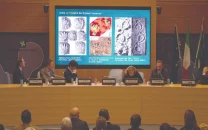How Napoleon’s army met its doom
DNA reveals two bacterial diseases that probably added to the death count

The retreat from Russia by Napoleon Bonaparte and the French Grande Armée in 1812 was a cataclysmic event that marked the beginning of the end for his empire and personal dominance in Europe, with about 300,000 soldiers perishing in a force that originally numbered roughly a half million.
A new study involving DNA extracted from the teeth of 13 French soldiers who were buried in a mass grave in Lithuania’s capital Vilnius along the route of the retreat is offering a deeper understanding of the misery the Grande Armée experienced, detecting two pathogens not previously documented in this event.
The discovery of the bacteria that cause paratyphoid fever and louse-borne relapsing fever showed, alongside previous work, that several infections had circulated among soldiers already enfeebled by cold, hunger and exhaustion. The Vilnius site, discovered in 2001, contains the remains of approximately 2,000 to 3,000 soldiers from Napoleon’s army.
“Vilnius was a key waypoint on the 1812 retreat route. Many soldiers arrived exhausted, starving and ill. A substantial number died there and were interred rapidly in mass graves,” said molecular biologist and geneticist Nicolás Rascovan, head of the microbial paleogenomics unit at the Institut Pasteur in Paris and senior author of the study published in the journal Current Biology.
“While cold, starvation and typhus have long been emphasized, our results show that paratyphoid fever and louse-borne relapsing fever were also present and may have contributed to debilitation and mortality,” Rascovan added.























COMMENTS
Comments are moderated and generally will be posted if they are on-topic and not abusive.
For more information, please see our Comments FAQ